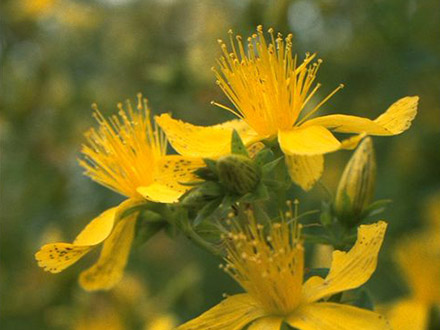Botanical name
Hypericum perforatum L.
Family
Hypericaceae
Common name
St. John’s wort
Information about the plant
There are around 380 species of hypericum worldwide, about 20 of them are found in Central Europe, including St. John’s wort. It is native throughout Europe and western Asia, the Canary Islands and North Africa, and has been introduced and naturalized in other continents. The genus name Hypericum is derived from the Greek "hyper" (= over) and "ereikon" (growing on the heath). There are various interpretations, such as "under heather growing taxon" or "the heather-like taxon". The species epithet perforatum is clear and refers to the translucent spots on the leaves, derived from the Latin "perforatus" (= pierced, perforated). It is also known as "spotted hard hay", indicating that its "hard" stalks produce little usable hay.
St. John’s wort grows along paths and field edges, along fences, on meadows and thickets. It grows about 60 cm high. The numerous yellow flowers, arranged in compound racemose cymes at the top of the hard, branched stems, are very striking. Like the leaves, the petals are dotted with glands, whereby the glandular oil reservoirs of the flowers appear black due to the dark red hypericin contained in them. If the fresh flowers are rubbed, the fingers are stained red. St. John’s wort flowers from the end of June to late summer.
Medicinally used parts of plants (herbal drug)
The dried flowering branch tips with flowers, leaves, and stems (Hyperici herba) are used. The commercially available drug comes mainly from cultivation in Germany, Eastern Europe, and Chile.
Constituents of the herbal drug
St. John's wort contains hypericin (naphthodianthrone), hyperforin (phloroglucinol derivative), flavonoids, and biflavones.
Quality of the drug
The quality of the following drugs or drug preparations is specified in the European Pharmacopoeia (Ph. Eur.):
- St. John’s wort (Hyperici herba)
- Quantified hypericum dried extract (Hyperici herba extractum siccum quantificatum)
- Hypericum for homeopathic preparations (Hypericum perforatum ad praeparationes homoeopathicas)
Medical applications
Recognised medical use
The HMPC has accepted St. John's wort in the form of dry extracts DER 3-7:1 (extractant methanol 80%) or DER 3-6:1 (extractant ethanol 80%) as "well-established use" for the treatment of mild and moderate depression. Dry extracts DER 2.5-8:1 (extractant ethanol 50-68%) can be used for a short time for mild depressive moods (well-established use). See also "Traditional use".
ESCOP: Internal use: dry extracts with ethanol (50-68%): mild depressive episodes; dry extracts with ethanol or methanol 80%: mild to moderate depressive episodes according to ICD-10, category F32.0, F32.1, F33.0, F33.1. St. John's wort powder, dry extracts 4-7:1, ethanol 35%, various liquid extracts, tinctures, and expressed juice from the fresh herb: for the relief of temporary states of mental exhaustion. St. John's wort powder is also used for mild gastrointestinal complaints. External use: tinctures of various strengths, extracts with plant oils: to treat mild skin inflammations (e.g. sunburn) or to heal small wounds.
Traditional use
The HMPC describes the following St. John's wort preparations for "traditional use": A: Dry extract (DER 4-7:1, extraction solvent ethanol 45%), B: Liquid extract (DER 1:4-20, vegetable oil), C: Liquid extract (DER 1:13, maize oil or other vegetable oil), D: Tincture (DER 1:5, ethanol 50-70%), E: Tincture (DER 1:10, ethanol 45-50%), F: Liquid extract (DER 1:2-7, ethanol 50%), G: Liquid extract of the fresh plant (DER 1:1, ethanol 96%), H: Expressed juice from the fresh herb (DER 1:0.5-0.9), I: Stabilized expressed juice from fresh herb (DER 1:1), J: Cut drug, K: Powdered drug.
The St. John's wort preparations A, C, D, E, F, G, H, J and K were classified by the HMPC as traditional herbal medicinal products (§ 39a AMG) based on long-standing use for the indication of "temporary mental exhaustion"; for preparations B, D, E and J the indication is "externally for the symptomatic treatment of mild skin inflammations (e.g. sunburn) and for healing”. For preparations I and J, the indication is "mild gastrointestinal complaints", and for preparation J, the indication is "nervous restlessness and sleep disorders". See also "well-established use".
Herbal drug preparations in finished dosage forms
- Cut St. John's wort as a tea
- Dried extract in capsules and tablets
- Liquid extracts for internal and external use
- Alcoholic extract drops and other liquid preparations
- Expressed juice from the fresh herb as juice
- Hypericum perforatum homeopathic mother tincture in liquid preparations
Dosage
Finished drug preparations: see patient information leaflet.
Tea infusion: A tea made from St. John's wort does not provide the effective dose for the treatment of depression, therefore, its ingestion is not recommended for this indication, and preparations with a defined content (quantified extract) should be preferred.
In the application areas of "traditional use" St. John's wort can also be drunk. Single dose of 1.5 - 2 g of St. John's wort, daily dose: 4.5 – 6 g.
Preparation of a tea
Pour 150 ml of boiling water over 1.5 – 2 g of finely cut St. John's wort and strain after 5 to 10 min.
Notes
St. John's wort has photosensitizing properties (hypericin content). Therefore, fair-skinned people with a high dose of hypericum may react with increased sensitivity to light and should consequently not be exposed to the sun.
The intake of St. John's wort during pregnancy and lactation is not recommended due to the lack of safety studies available. Also, there is no evidence for its use in children and adolescents under 18 years old.
Side effects
Rare: sometimes allergic skin reactions, fatigue, anxiety or gastrointestinal complaints.
Interactions
St. John's wort increases the activity of different subtypes of the cytochrome P450 enzyme system, leading to interactions with drugs that are metabolized by these enzymes, resulting in a weakened effect. This applies to anticoagulants of the coumarin-type (e.g. phenprocoumon), cyclosporine and tacrolimus (immunosuppressive drugs), digoxin, indinavir and other protease inhibitors (HIV treatment), cytostatics, hormonal contraceptives (pill), amitriptyline/nortriptyline (antidepressants), and theophylline.
References
Herbal drug monographs
HMPC (2023), ESCOP (2018), WHO (Vol. 2, NIS)
Further literature
Commentary on the European Pharmacopoeia (St. John's wort, No. 1438; Quantified dry extract of St. John's wort, No. 1874; Hypericum for homeopathic preparations, No. 2028)


